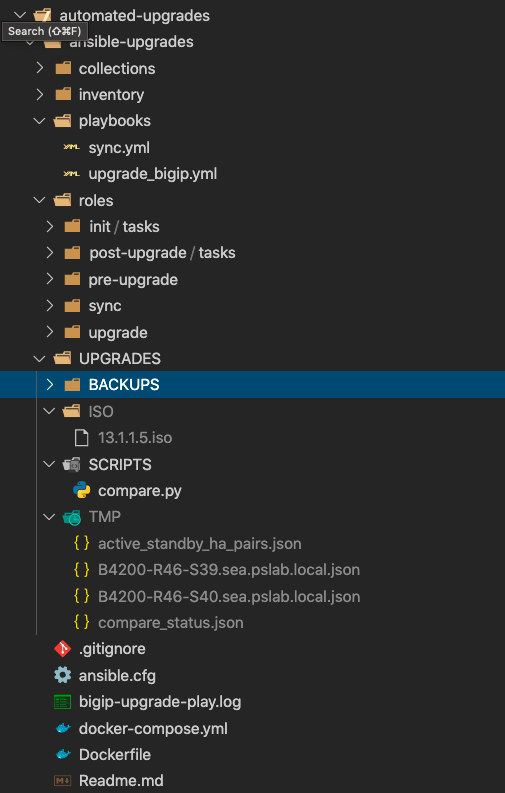- master - uses the bigip_device_info for validation. Currently slower than command-validation branch. Bug open - # 1827
- command-validation - uses a tmsh command for validation - significantly faster
- git clone [email protected]:arunhotra/ansible-bigip-upgrades.git
- modify inventory file according to your needs
- docker-compose run upgrade-bigip
- [from shell] ansible-playbook playbooks/upgrade_bigip.yml -vvv
- Ansible 2.9
- Latest ansible collection installed - https://galaxy.ansible.com/f5networks/f5_modules. Use the command "ansible-galaxy collection install f5networks.f5_modules -p ./collections" so that the collections can be installed locally. The ansible config file currently points to the collections which are local.
- f5-sdk - pip3 install f5-sdk
- objectpath module (for sync) - pip3 install objectpath
- Inventory populated
- Ansible controller with access to internal BIG-IP and reachable to F5 license server
- Ensure that there is an UPGRADES directory inside the parent folder (same level as inventory, playbooks and roles)
- Inside the Upgrades directory, there is a SCRIPTS directory with compare.py
- Create another direcory called ISO inside of UPGRADES and add the target BIG-IP image inside the ISO directory
- Your directory will look like this

- Populate the inventory file with the hosts, both A and B. An example is provided in the invnetory file
- From the parent directory , run the command ansible-playbook playbooks/upgrade_bigip.yml
- Verbosity levels can be used (-v,-vv,-vvv)
- Each role uses a tag (except init which runs always), the tags feature can be leveraged if you only want to run a certain role for testing. For example, ansible-playbook playbooks/upgrade_bigip.yml --tags "pre-upgrade" -vvv
General guideline - work on standby first, compare with active. If things look good faiover and repeat process on active.
- Upload the image with the version that you will be upgrading to
- Take backups ucs, qkview
- Disable traps
- Select inactive volume, delete it
- Install software into deleted volume and activate
- Once BIG-IP is booted into the new version, compare stats with the active device (log these stats as well)
- Note - currently the pool status is being compared - modify accordingly based on your needs
- If everthing looks good, failover and repeat the process on the other device
- Roles run first and then after the success criteria is true.
- The upgrade_success variable indicates that that particular upgrade (box A or B) was successful based on the comparison criteria (pool status comparison in this case)
- Description of roles below
-
Initializes variables, initializes success variable seperately, populates hosts from the inventory, populates the active standby pairs.
-
Note that all the tasks in the init-hosts always run
-
The standby_host variable controls
-
Uploads image, takes qkview, ucs and re-licences
-
Pauses for 60 seconds after the volume is deleted
-
prepare the volume - delete the nearest inacvive volume
-
If there is only one volume - it chooses "HD1.10" as a safe bet and installs the software on that volume
-
upgrade the guest - install software on the chosen volume and boot into that volume
-
compares the pool status and sets the upgrade_success variable accordingly.
-
It gets pool status output from active and standby and writes them to a file, then a python script compares the two files and writes a file called compare_status.json. If any of the guests fail to show successful comparison, then the upgrade success value is set to false.
- Post upgrade sync - sync's from active to standby by using the bigip_configsync_action module. This is to get rid of the "changes pending" message after the upgrade.